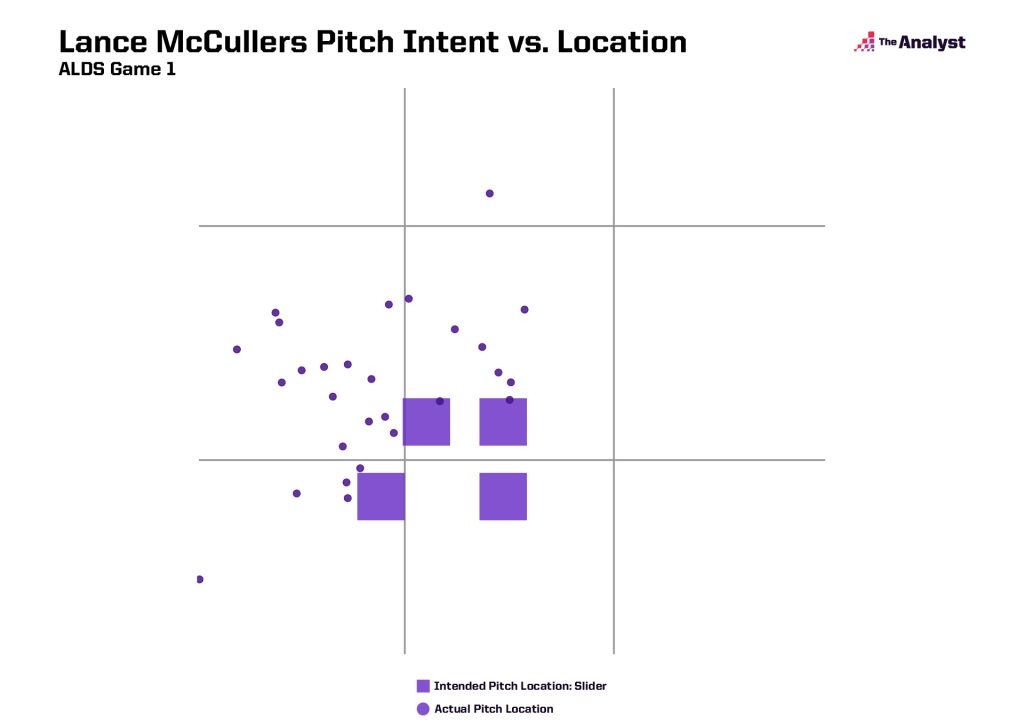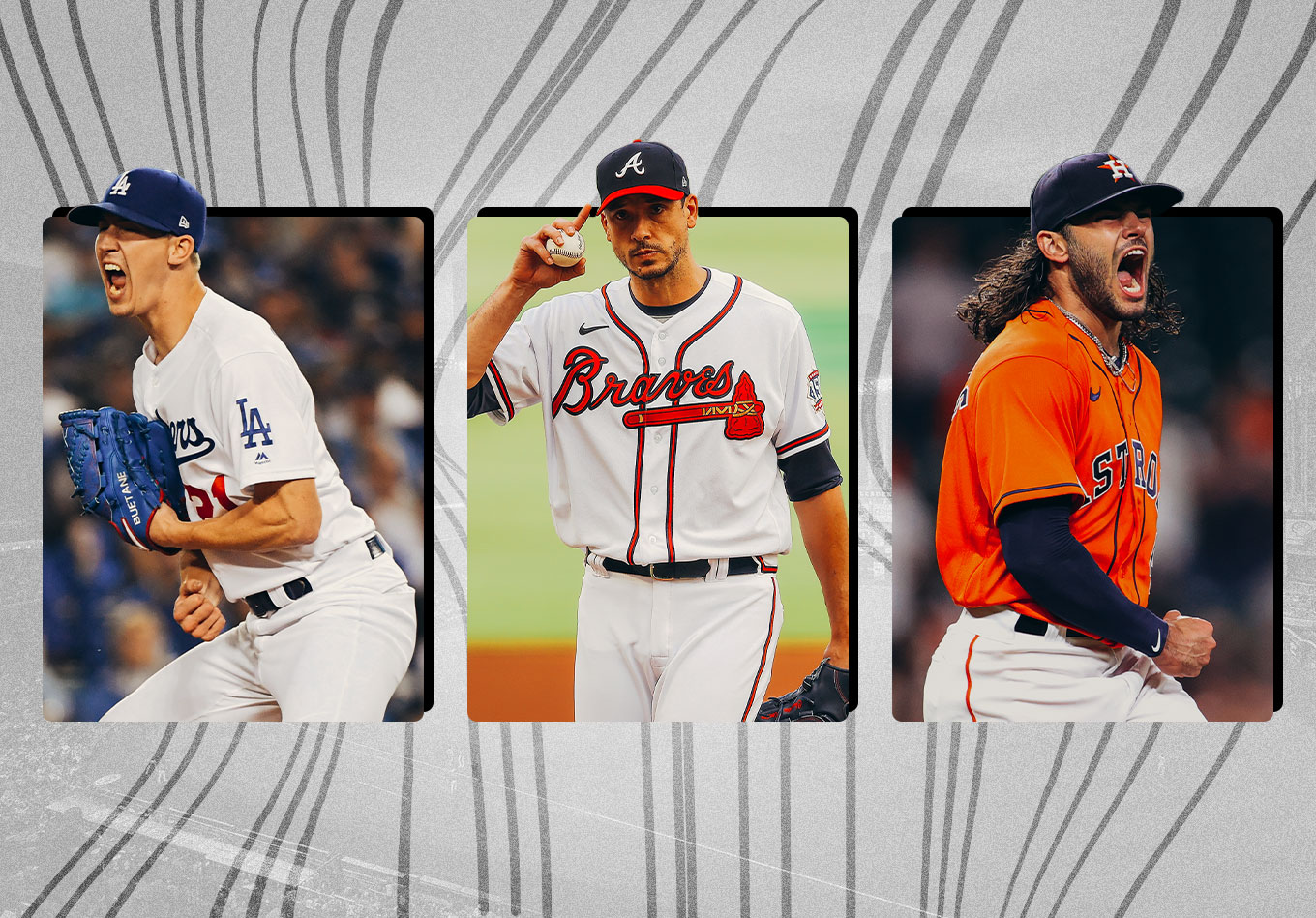Three more playoff games with huge implications, three more interesting pitching matchups. Let’s conclude with Walker Buehler vs. Anthony DeSclafani in Game 4 at Dodger Stadium.
The Dodgers Hope to Force Game 5 With Walker Buehler on the Mound
After a narrow defeat in a pitcher’s duel in Game 3 of the National League Division Series, the Los Angeles Dodgers are suddenly facing elimination on their home field.
The San Francisco Giants hope to close them out Tuesday night when Anthony DeSclafani makes his postseason debut on the mound. The former Florida Gator was much more successful in the first half of the season (2.68 ERA) than he was in the second (4.03).
Against right-handed hitters, DeSclafani attacks with four and two-seam fastballs, and sliders. His slider accounts for 41.8% of all his pitches thrown to righties in 2021. Against lefties, he sticks with his four-seam fastball, slider, and changeup, while also sprinkling in some curveballs and two-seamers.
Though not his most used pitch, look for his two-seamer to be an effective tool tonight. In 2021, opponents only hit .183 against the pitch and the right-hander will most often use it to neutralize the lefties in the Dodgers lineup.
Against both righties and lefties, look for DeSclafani to throw his four-seam fastball up in the zone when he’s ahead in the count. Of fastballs thrown in this situation, 67.5% are up in the zone.
DeSclafani Four-Seam Fastball Intent Ahead of the Count

Will Smith should feel comfortable in the box against DeSclafani as he’s 6 for 12 with two home runs, a triple and five RBIs against him this season. Cody Bellinger, however, has gone just 1 for 12 lifetime in this matchup.
The defending champs are turning back to Game 1 starter Walker Buehler with the season on the line. The right-hander will go on short rest after allowing three runs over 6.1 innings in a 4-0 loss on Friday in San Francisco.
Buster Posey is just 2 for 14 when facing Buehler this season, but he homered off him in the series opener. Kris Bryant, who also went deep in that contest, is 6 for 16 lifetime against Buehler, but LaMonte Wade Jr. (2 for 13) and Brandon Crawford (4 for 26) haven’t fared as well.
Posey’s home run came on a 3-0 four-seam fastball that got a bit too much of the heart of the plate.
Bryant’s long ball was on a nearly identical pitch. Though on a full count, Buehler’s fastball to the former Cubs slugger was not located very well.
As discussed in the Game 1 preview, Buehler uses a large arsenal of pitches to get hitters out. When he falls behind hitters, particularly righties, he can get a bit predictable. When behind to righties, he throws fastballs (four-seam and two-seam combined) 75.9% of the time.
Walker Buehler Behind in Count vs. Righties
| Pitch Type | Count | Usage |
|---|---|---|
| Four-Seam Fastball | 167 | 65.7% |
| Two-Seam Fastball | 26 | 10.2% |
| Curveball | 10 | 3.9% |
| Slider | 36 | 14.2% |
| Cutter | 15 | 5.9% |
Two Giants sluggers were able to pick up on this trend and capitalize on his fastballs to give the Giants the lead in the series. Getting ahead in the count to hitters tonight could prove imperative as Buehler tries to silence San Francisco’s offense with his offspeed and breaking pitches.
-ZD
The Braves Look to Close out the Brewers in Game 4 Behind Charlie Morton
With an opportunity to close out the NL Central champion Milwaukee Brewers on their home field in Game 4, the Atlanta Braves aren’t messing around.
Atlanta manager Brian Snitker is giving the ball to playoff veteran Charlie Morton on three days of rest at Truist Park with his club up 2-1 in its National League Division Series. The right-hander hasn’t made a start on short rest since his rookie season in 2008.
Morton, however, has been a reliable postseason performer in recent years, going 6-2 with a 2.36 ERA in his last 10 starts dating to the 2017 playoffs when he won a World Series with the Houston Astros. He pitched well again in Game 1 of this series, allowing two runs and three hits while striking out nine over six innings in a 2-1 loss.
Morton threw his curveball more than any other pitch (36.7%), even his four-seam fastball (36.2%), during the regular season. But against the Braves in the opener, he threw his four-seamer 47.1% of the time compared to 42.4% of his 85 pitches for his curve.
The biggest change in his approach came with two strikes. During the regular season, Morton went to the curve 47.4% of the time and used the four-seamer 38.8%. In Game 1, 14 of his 26 two-strike pitches were four-seamers – nine versus right-handed batters. It should be interesting to see if that trend continues in Game 4.
Against left-handed batters, he continued to be a two-pitch pitcher with the four-seamer and curve in the opener. He threw 15 of his 30 curveballs versus lefties when he was ahead in the count. With two strikes, Morton will try to either dive a curve down below the zone (he did this 10 times in Game 1) or throw a four-seamer up and away (he did this on five occasions).
But he missed his spot on one of these fastballs in the seventh inning when Rowdy Tellez clubbed a two-run home run to give Milwaukee the lead for good. In the clip below, you can see Atlanta catcher Travis d’Arnaud set up high and away from Tellez.
Milwaukee has opted not to turn to ace Corbin Burnes with the season on the line. Instead, the team will send left-hander Eric Lauer (7-5, 3.19 ERA) to the mound.
Lauer throws his four-seam fastball at a 44.5% clip, but then he also has four other pitches (curveball, slider, changeup, cutter) that he uses between 11.0-18.7% on the other occasions.
Whether he’s facing a lefty or righty, Lauer’s intention is to work low and away to get ahead with the four-seamer (46.1%) while mixing in the curve (17.6%), slider (6.6%) and cutter (19.1%). But against righties only, he adds a changeup every now and then (14.0%).
Eric Lauer Intent on First Pitches

With two strikes, Lauer primarily tries to work away from a left-handed batter with the fastball (53.8%) – up or down – or the curveball (20.8%) – down and away. He has a similar strategy against righties, except that he’ll throw more sliders (14.6%) – down and in.
Eric Lauer Pitch Intent With Two Strikes

In his only career meeting with the Braves, Lauer allowed three runs and four hits – including two home runs – over three innings of relief in a 6-3 loss on May 14. Ozzie Albies, who has two doubles in this series, homered off Lauer in that contest.
-TB
Can the Sox Solve Lance McCullers Jr. and Extend Their Season in Game 4?
The Chicago White Sox managed to avoid a sweep Sunday at Guaranteed Rate Field, where they had the best home record in the American League at 53-28. Now down 2-1 to the Houston Astros in the American League Division Series, they need to continue to overcome adversity to stay in this series.
If there’s one White Sox pitcher with experience in that, it’s Carlos Rodón. The former first-round draft pick had shoulder surgery in 2017 and Tommy John surgery in 2019, but he’s worked his way back and had a resurgence in 2021.
Rodón was dominant for most of the season, finishing with a 2.37 ERA in 132.2 innings pitched with 185 strikeouts. He went right after hitters with a deadly four-seam fastball and slider combo, making up for 85.0% of his pitches thrown.
The slider had a whiff+ of 109, but was even harder to square up. BIP+ tells us about the quality of contact against a particular pitcher or pitch and is also standardized to 100. For this stat, lower is better since it indicates worse contact quality. Rodón’s slider BIP+ for 2021 was 26 or 74% better than league average.
He consistently buried the pitch to his glove-side, making it very difficult to hit for left- and right-handers alike.
Carlos Rodón 2021 Slider Intent

The fastball was the key to success for Rodón, though. Topping out at 100.5 mph and averaging 95.4 mph, it generated a whiff+ of 171 and BIP+ of 74.
However, the left-hander missed some time in August with another shoulder injury. He made four starts in September to get ready for the playoffs but wasn’t quite the same. His fastball averaged 92.9 mph and topped out at 97.8 mph. More alarming, the hardest fastball he threw in his last start was 92.7 mph.
Everything starts with velocity for Rodón. He has to empty the tank today to keep Chicago’s postseason hopes alive.
Former American League Central foe Michael Brantley has struggled in their lifetime matchup, going 3 for 30.
Dusty Baker and the Astros are hoping to end the series in Chicago before the White Sox can gain any more momentum. With an extra day rest due to Monday’s rain postponement, Baker has moved Lance McCullers Jr. up in the rotation for his second start of the series.
McCullers was lights out in his first outing, going 6.2 scoreless innings in Houston’s 6-1 victory in Game 1. His AL-leading ground ball percentage paired with the White Sox ranking third in MLB in ground ball percentage offensively led to McCullers allowing only four hits with solid infield defense behind him.
With a few more right-handed hitters in the lineup, McCullers increased his two-seam fastball and slider usage a little bit. He threw the two-seamer 37.5% of the time compared to 33.8% and the slider 27.9% compared to 25.6%.
His slider got the most whiffs of any of his pitches, as he consistently placed it just off the edge of the strike zone. It looked like a strike until the last moment and White Sox hitters were fooled again and again.

McCullers did stick to his usual breaking ball approach though. He threw 20 of his 22 curveballs to left-handed hitters and 27 of his 29 sliders to right-handed hitters. He also threw one of the 11 changeups to a righty, something he’s only done 7.0% of the time this season.
That changeup was to Luis Robert, who led the White Sox offense by going 2 for 3 and reaching base three times. José Abreu was 2 for 4 with a walk, while Tim Anderson, Yoán Moncada, and Eloy Jiménez had a hit a piece in the game.
Can the Astros punch their ticket to a fifth straight American League championship Series tonight? Or will the White Sox continue the fight at home?
-JL
Design by Matt Sisneros.
